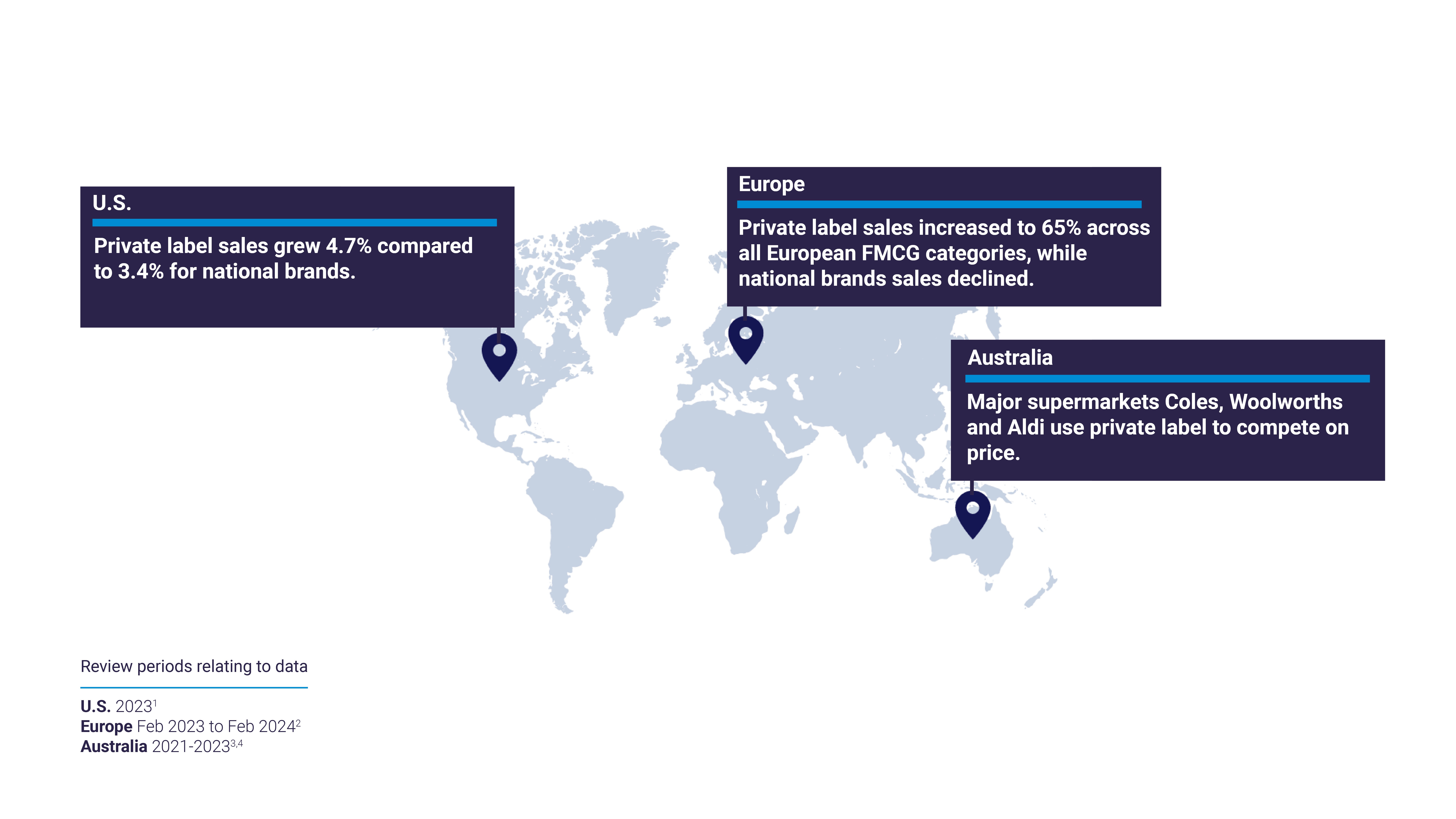Private label food brands seek to compete within a food category to offer consumers greater choice, often at lower prices, as an alternative to leading brands in the same category. Consumers value different price points and overall quality when making purchases. As a result, in today’s market, where awareness of rising food prices and the cost of weekly groceries is high, more and more consumers are opting for low-cost private label products. As retailers continue to move towards even more customer-centric strategies, food manufacturers and co-packers must learn to embrace this shift in strategy and the upward trend in private label that is being seen in many parts of the world.
Private label is growing on three continents
According to the Private Label Manufacturers Association, private label sales will reach a new record high, with the market exceeding $250⁵ million. Another survey, by Nielseniq, found that more than half⁶ of retailers expect private label to be their main growth driver by 2024.What is clear is that food and beverage manufacturers or contract manufacturers have an opportunity for scale and differentiation more than ever before. Over the long term, this private label segment can generate additional revenue and provide long lasting prospects. For retailers, the benefits are speed to market and faster product launches for new ranges.
But where there is opportunity, there is also risk.
What are the risks of increased private label demand in the packing hall?
1. Labelling errors
The more private label brands there are, the more labelling changes there are in the packaging hall. As the frequency increases, the likelihood of coding and labelling errors becomes statistically more significant. Each brand will also experience label changes over time due to reformulation, brand change and packaging change. In addition, as retailers adopt more consumer-centric strategies, the frequency of label changes may increase.
Take Sam’s Club in the US, which is taking customer engagement to new heights. They introduced co-creation of specific product lines for their private label Member Mark in 2024. They asked 50,000⁷ shoppers to help shape specific product lines. Seeking such ongoing feedback can in itself be a driver of change, along with promotional and regulatory activity, all of which is leading to an increased frequency of labelling change requests.
The impact of label errors
If the printers inadvertently produce an incorrect label, or an operator on the packaging line inadvertently uses an incorrect label, there is a potential risk of an undeclared allergen or an incorrect weight. Potential undeclared allergens could result in a product recall and reputational damage.
Solutions for the elimination of labelling errors in the packaging hall
Automated approach
Paperless quality
Vision inspection system
2. Non-disposed labels or product packs
Where there is a high volume of products and packaging variations of different private label brands, at different packaging stages, all operating within the same packaging hall space, there is a risk of incorrect labels and products being used in the wrong shift. Particularly when frequent label changes are involved, it can be difficult to understand which label variant is in use when remnant packaging is in play, leading to assumptions and errors at critical times of operation.
The impact of leftover labels or product packs
If remnant label variants or product packs from a previous shift are packed and the contents contain allergenic ingredients, there is a significant risk that a product recall is required due to undeclared allergens. These mixed labels or product packs may end up on a pallet of mixed SKUs.
Solutions to address the risk of labels or product packaging not being disposed of properly
Paperless quality
Label verification
Automated workflows
Vision inspection system
3. Label rolls or stacked labels containing mixed labels
With frequent label changes, there is an increased potential for operators changing the reel to inadvertently introduce an incorrect label. This is due to the natural unwinding of the old label during the reel changeover period, or splicing in the wrong reel label position. Similarly, when printing multiple SKUs on one label sheet, there is a risk of mixed labels being printed side by side, resulting in the wrong label being applied to the product.
The impact of mixed labels on label rolls and label stacks
Product recalls will be carried out where mix-ups of product and labelling have been identified in relation to allergenic ingredients and undeclared allergens.
Solutions to address the risk of mixed label rolls and stacks
Paperless quality
Vision Systems
If your focus is on continuous improvement and you value the role that automation plays in bringing control to your packaging line processes, please contact one of our experts. We are here to support your growth plans and to help you build greater confidence with your retailers.
Source
1. Market Research, 2024, Private label in US produced record-setting sales, PLMA, Private label in US produced record-setting sales | PLMA (plmainternational.com)
2. Bracknell, UK, 30 April 2024, ‘Promotional boosts fail to lift volume sales in Europe’, Circana, Promotional boosts fail to lift volume sales in Europe – Circana
3. Isabelle Lane, Feb 9 2021, ‘From e-commerce to Private Labels: The pandemic shopping trends that are here to stay, Smart Company, E-commerce and private labels: These pandemic shopping trends will stick (smartcompany.com.au)
4. Kylar Loussikian, July14 2023, ‘Woolworths, Aldi winning the supermarket wars: suppliers’, Financial Review, Woolworths, Aldi winning most market share: UBS survey of suppliers (afr.com)
5. Ananda Roy, 30 April 2024, ‘Promotional boosts fail to lift volume sales in Europe, Circana, Promotional boosts fail to lift volume sales in Europe – Circana
6. Analysis, 14 May 2024, ‘Branded vs. Private Label – who is going to come out on top?’ NIQ Branded vs. Private Label – who is going to come out on top? – NIQ (nielseniq.com)
7. Sam’s Club, June 6 2024, Sam’s Club Unveils Dynamic Consumer Engagement and Feedback Community to Co-Create Products with Members Sam’s Club Unveils Dynamic Consumer Engagement and Feedback Community to Co-Create Products with Members (walmart.com)



